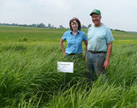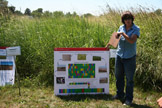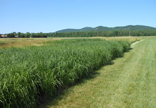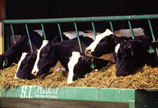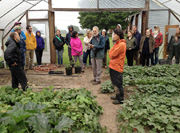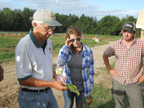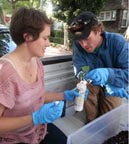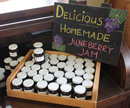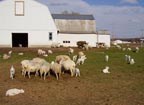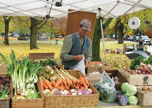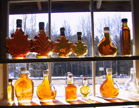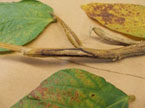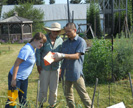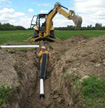 This gallery features web-resolution images. For additional and higher resolution images or assistance, please contact karalynn@gisco.net or 315.465.7578.
This gallery features web-resolution images. For additional and higher resolution images or assistance, please contact karalynn@gisco.net or 315.465.7578.
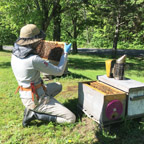 NNY Bee Health Project:
NNY Bee Health Project:
Cornell University Honey Bee Extension Associate Emma Mullen inspects a hive in Northern New York. Photo: Mary Kay Wheeler.
Click here for high res version
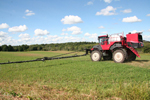
Applying biocontrol nematodes in Northern New York. Photo: Northern New York Agricultural Development Program
Click here for high res version
Cornell University researcher Hilary Mayton and switchgrass grower Tom Lee check a Northern New York Agricultural Development Program-funded bioenergy field crop trial at Tom’s farm in St. Lawrence County. Photo: Brian P. Whattam
Cornell University researcher Hilary Mayton presents information at a field day at the NNYADP-funded bioenergy grass trials at Belleville-Henderson Central School, Belleville, NY. Photo: NNYADP/Kara Lynn Dunn
Northern New York Agricultural Development Program-funded switchgrass research trial plots at the Cornell Willsboro Research Farm, Willsboro, NY, in 2013. Photo: Jerry Cherney
COLD HARDY GRAPES & WINE
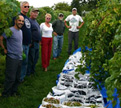
Research on novel cold-hardy grape varieties for production in NNY is among the projects funded in 2015 by the farmer-driven Northern New York Agricultural Development Program. At left, growers in the Lake Champlain region celebrate the harvest of the cold hardy grape trials planted in NNY at the Cornell Willsboro Research Farm, Willsboro, NY; photo: Kevin Iungerman, Northeastern NY Commercial Fruit Program
DAIRY
The Northern New York Agricultural Development Program funds research that is critical to the regional dairy industry across Clinton, Essex, Franklin, Jefferson, Lewis and St. Lawrence counties. In 2015, Cornell University and Extension educators studied the impact of calf housing on young cow respiratory health. Photo: USDA ARS
The Northern New York Agricultural Development Program-funded has funded research by the Miner Institute in Chazy, NY, and by Cornell University and Extension educators on how crop quality, feeding program management and feed ration composition impact cow health. Photo: USDA/Scott Bauer
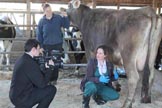 At left, Dr. Jessica Scillieri-Smith talks with WWNY TV 7 News Reporter Tyler Head as she collects a milk sample at Hy-Light Farms, one of 143 farms participating in the NNYADP-funded project identifying lesser-known mastitis causes. Holding the Brown Swiss cow is farm co-owner Heather Hyman. Photo: NNYADP/Kara Lynn Dunn
At left, Dr. Jessica Scillieri-Smith talks with WWNY TV 7 News Reporter Tyler Head as she collects a milk sample at Hy-Light Farms, one of 143 farms participating in the NNYADP-funded project identifying lesser-known mastitis causes. Holding the Brown Swiss cow is farm co-owner Heather Hyman. Photo: NNYADP/Kara Lynn Dunn
FIELD CROPS
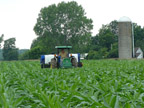 At left, Reed Haven Farm, Adams Center, hosts trials with a 3-way interseeder developed at Penn State. The Northern New York Agricultural Development Program funded research by Dr. Matthew Ryan of the Sustainable Cropping Systems Lab at Cornell University on the use of early crop interseeding. The interseeder bundles 3 operations into one implement that simultaneously seeds cover crops while applying post-emergence herbicide and sidedress nitrogen fertilizer to corn, the primary crop of interest. Photo: Matthew Ryan
At left, Reed Haven Farm, Adams Center, hosts trials with a 3-way interseeder developed at Penn State. The Northern New York Agricultural Development Program funded research by Dr. Matthew Ryan of the Sustainable Cropping Systems Lab at Cornell University on the use of early crop interseeding. The interseeder bundles 3 operations into one implement that simultaneously seeds cover crops while applying post-emergence herbicide and sidedress nitrogen fertilizer to corn, the primary crop of interest. Photo: Matthew Ryan
HORTICULTURE
The Northern New York Agricultural Development Program funds season extension opportunity research that includes the use of high tunnels. At left, growers attend a field day to hear the latest results on high tunnel crop production. Photo: Amy Ivy/CCE Clinton County
With Northern New York Agricultural Development Program funding, Cornell Cooperative Extension educators brought Cornell University Horticulture Professor Dr. Stephen Reiners, left, to NNY for workshops with organic and conventional production vegetable growers. Dr. Reiners presented information on soil fertility and irrigation and provided growers with real-life, short-season case studies from research conducted on NNY farms.
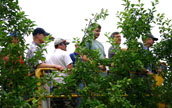 Northern New York Agricultural Development Program-funded precision apple orchard management trials at NNY farms is targeted at increasing efficiency and profitability. At left, NNY apple growers participate in an orchard thinning workshop aboard a mechanical platform. Photo: Kevin Iungerman
Northern New York Agricultural Development Program-funded precision apple orchard management trials at NNY farms is targeted at increasing efficiency and profitability. At left, NNY apple growers participate in an orchard thinning workshop aboard a mechanical platform. Photo: Kevin Iungerman
INNOVATIVE CROP DEVELOPMENT: Juneberry
Funding from the farmer-led Northern New York Agricultural Development Program has established one of the world’s largest Juneberry (Amelanchier) research nurseries and living collections of Amelanchier at the Cornell Willsboro Research Farm in Willsboro, NY. At left, Juneberry project leader Dr. Michael Burgess of SUNY Plattsburgh examines an amelanchier cutting. Photo courtesy of Dr. Michael Burgess
Juneberry has been dubbed a “super fruit” with economic potential as a value-added crop. Northern New York Agricultural Development Program-funded research has established New York state’s first Juneberry research trial nursery at the Cornell Willsboro Research Farm in Willsboro, NY. Photo: NNYADP/Kara Lynn Dunn
Researchers with 2015-16 Northern New York Agricultural Development Program funding are evaluating tools to increase the competitiveness and profitability of beef stocker operations; photo: USDA/Don Tanaka
Downing Acres, at left, Burke, NY, participated in NNYADP-funded research evaluating parasite control options for small livestock producers. Farm owner Beth Downing noted, “Sheep farming is our livelihood and parasites can take a heavy toll on breeding ewes and on weight gain in lambs. We use a combination of strategies to keep our sheep healthy and control parasites, including rotational grazing, deworming, keeping good records, and participating in research to learn new ways.”
In April 2015, the Northern New York Agricultural Development Program has posted preliminary results of a survey asking regional consumers, food buyers, and farmers about their interest in developing a local food hub. At left, Dan Kent of Kent Family Growers, Lisbon, NY, at a NNY farmers’ market; photo courtesy of Kent Family Growers.
Northern New York Agricultural Development Program-funded research in 2011-2013 evaluated the effectiveness of a relatively inexpensive changeout of equipment to improve sap gain. Data analysis showed more than $12,000 in potential profit from unrealized sap yield in one 3,000-tap sugarbush in the West Chazy area. In 2015, NNYADP-funded researchers are evaluating opportunities for maple producers to add birch syrup production as an additional revenue stream.
PEST & DISEASE MANAGEMENT
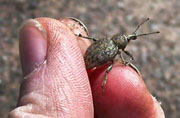 Alfalfa snout beetle; photo: Shields Lab at Cornell University
Alfalfa snout beetle; photo: Shields Lab at Cornell University
Nov. 2015: Regional agribusinesses are the latest beneficiaries of the nearly 30 years of research dedicated by the farmer-driven Northern New York Agricultural Development Program to finding a solution to alfalfa snout beetle, an invasive insect that threatens alfalfa crops highly valued by dairy and livestock producers. Read more
Northern Stem Canker; photo: Jaime Cummings/Cornell University.
As part of 2014 NNYADP-funded NNY Corn and Soybean Diseases Diagnosis and Assessment Database project, Cornell Cooperative Extension Field Crops Specialists Mike Hunter and Kitty O’Neil scouted and sampled fields across the northern NY region. They worked directly with Cornell Plant Pathologist Dr. Gary C. Bergstrom and the Cornell University Field Crop Pathology Laboratory which confirmed for the first time in New York soybean fields the presence of northern stem canker.
Reported yield losses in the Midwest have ranged from minor to in excess of 50%, so the presence of the pathogen is considered a significant factor for soybean production. NSC was identified in NNY in samples from Jefferson County; it was also identified in fields in Livingston, Niagara, Ontario, Orleans, Seneca and Wayne counties.
Leek moth detection in NNY: Cornell University entomologist Dr. Masanori Seto, at right, shows two NNY vegetable growers a trap for catching leek moth, a pest that damages onion, garlic, chives and other allium crops. With funding from the NNYADP, Seto identified the range of leek moth in 2013. Leek moth was first detected in the U.S. in Northern New York in 2009 in garlic and onions in Plattsburgh, Clinton County. The pest was identified in St. Lawrence County near Canton in 2010. Additional sites were added in those counties in 2011. Commercial growers in Essex and Jefferson counties reported finding leek moth in their fields in 2012. Photo: Amy Ivy/CCE Clinton County
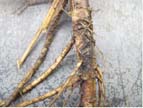 Brown root rot (BRR), caused by the fungus Phoma sclerotioides, was first identified in New York State in 2003 in northern NY in Clinton County. The cold-weather disease damages alfalfa crops, a valuable dairy and livestock feed crop and cash crop. Northern New York Agricultural Development Program research has confirmed areas of BRR by field survey, has helped farmers begin to recognize the disease, and has begun creating management strategies.
Brown root rot (BRR), caused by the fungus Phoma sclerotioides, was first identified in New York State in 2003 in northern NY in Clinton County. The cold-weather disease damages alfalfa crops, a valuable dairy and livestock feed crop and cash crop. Northern New York Agricultural Development Program research has confirmed areas of BRR by field survey, has helped farmers begin to recognize the disease, and has begun creating management strategies.
A field trial currently planted in NNY is evaluating alfalfa yield impact after exposure to BRR and ice sheeting. Photo: Julie Hansen/Cornell University
TILE DRAINAGE
